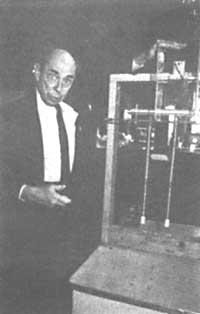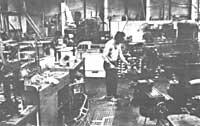Unknown Oppenheimer
1985/12/01 Barandiaran, Mariaje | Irazabalbeitia, Inaki - kimikaria eta zientzia-dibulgatzaileaElhuyar Fundazioa Iturria: Elhuyar aldizkaria
Early years
Frank Oppenheimer was born in New York in 1912, 8 years younger than Robert. As a young man he shared his time between horse, sailing and flute.

When he graduated from Johns Hopkins University in 1933 he went to Europe. First he worked with Rutherford in Cambridge, then went to Firence to the Institute of Arcetri. At the Galería di Uf> he spent a lot of time enjoying his wonderful works of art. There came a deep love for art.
Returning to North America in the late 1930s, he trained a four-year doctorate at the California Institute of Technology. She also met Berkeley student Jacquenette Quann and married her. Both joined the Pasadena branch of the Communist Party. This fact, as we shall see later, marked his life.
Next, Ernest O was inventor of the cyclloton. He began working at Lawrence's laboratory in Berkeley. His work consisted in the separation of Uranic isotopes by electromagnetism. This work opened the doors of his later work, helping him in the construction of the first atomic bomb. Although he first worked at Oak Ridge, he was soon transferred to "Los Alamos", directed by his brother. He could also see the first atomic explosion.
Political problems
For the construction of the atomic bomb they worked on the Manhattan Project, like many other scientists, and later faced it with enthusiasm. This courageous attitude aggravated their political problems.
In the United States, the cruel anticommunist that began after the war is known. By the hand of Senator McCarthy, he was hunted for witches and accused of having anti-American positions and dismantling America. In this dark and black age of McCarthy many men of culture were persecuted and investigated, in addition to rage ( Charles Chaplin, Einstein himself, Joseph Losey, etc. ).
Among them are the Oppenheimer brothers. Robbert, who did not have a clear militancy on the left, suffered a small punishment, prohibited him from examining classified documents. However, Frank was severely punished because of the famous communist militancy. The punishment was aggravated because his former companion did not want to denounce him. He was not prosecuted but received the punishment otherwise.
At that time he was a professor and raped of the University of Minnesota who abandoned his work and research. It was finished as his experimental physical career, as the doors of other universities were closed to him.
Livestock in Colorado
With this sad event the life of the Oppenheimer changed radically. They abandoned the whirlwind of the modern world and moved as cattle ranchers to the Pagosa Spring of Colorado, located at 2,000 meters of altitude. They started with 200 cows and calves and in Frank's words, "We became obstetricians." Pagosa Spring's winters were harsh, aggravated by isolation.
However, he could not get rid of the persecution of the FBI; the people of the town often wondered about the things of Oppenheimer and also the postman of the people had to take note of the recipients and senders of the letters sent and received by Oppenheimer.
Oppenheimer's open character succeeded in breaking the distrust of his fellow citizens. He became president of the telephone company, with 13 subscribers, president of the land conservation commission and representative of the livestock association. Later came the need for a school science teacher from Pagosa Springs. Profiding this option Oppenheimer grabbed him and rejoined the teaching. 10 years after shipping from the University of Minnesota.
Back at university
At that time the new era of artificial satellites was born. The Soviets just launched Sputnik and in the United States there was a panic that the Soviets could be more than the Americans. Good scientific and qualified teachers were needed. As one of these Frank Oppenheimer opened the doors of the university. Indirectly, to teach a teacher training course, in principle but in its entirety. He was appointed professor of physics at the University of Colorado.
The return to college led him to discover a dangerous problem, that the vacuum that was spreading between scientists and street people was growing wider.
Back in Europe
In 1965 he returned to Europe with a scholarship to University College London. During this stay he had the opportunity to visit three museums that gave him an effective impression. The conclusion was that America needed new museums. At the Science Museum in Kensington, England, children could change and play with him. At the Palais de la Decouverte in Paris, schoolchildren taught and explained what they had taught. Oppenheimer impressed the degree of involvement of school teachers at the Deutsches Museum in München.
New vision on science museums

When he returned to America he began daring everything he saw. He thought that museums in general and science museums in particular, rather than being a showcase to accumulate meaningless things, should be an agent that concerns the visitor. Not only should they be places to show the advances of science, which would contribute to sustaining that almost mystical attitude of street people towards science, but they would help bring the visitor closer to the knowledge of the foundations of science. He thought that this increasingly widespread vacuum between scientists and street people he discovered could be a good way to start closing it.
The Exploratorium, which opened in San Francisco in 1969, is the son of these ideas. It is a museum that wants to provoke exploration. (See combo). Although the Museum opened without applause, today it exceeds 500,000 visitors annually and has been copied worldwide. The museum is spacious and open, in order to facilitate the public the most direct contact with what is exposed in the museum. On this route, for example, you can get a valid entry card for six months.
Frank Oppenheimer will no longer be able to walk through the halls of the Exploratorium, looking at what visitors, especially children, explore and enjoy their successes. A bad lung cancer led him forever to the hunting grounds of good people in the early days of the year.
In an interview two years ago, Frank Oppenheimer talked about the background and organization of the "Exploratorium". In Hern, we will transcribe part of that conversation. "...When we created the Exploratorium fourteen years ago, our goal was to eliminate the distance that separates man and the street expert. We wanted a vacuum that increasingly separates life and daily experience from each of us from a world as complex as science and technology. At the Exploratorium, people have the possibility to get to know some aspects of culture that they consider immature. At the Exploratorum we want people to become aware of who they are, who can understand the world, who are not obliged to lean on expert decisions and that barriers can also participate... ...We have Ithrado of a system of obligations that make a school unsustainable for most, and we try it from afar with some note or punishment (Not to whom Intzari has. One of our rules is to value the visitor in a trial or competition situation... ...In order to maintain that freedom, we have held our sessions so that we can use them multiple. The modules related to a single action are equipped with the fingers of a... ...Our role is that of that good tourist agency. We offer our customers the necessary resources, both conceptual and instrumental, so they can use I in a comfortable way what others discovered with great effort. That is why, once again, we are in a situation of superiority with the institution of the school. One class has to start at one point and end at another: a program must be followed. Thus, the tourism proposed in the school on the trains of the air conditioning lines, in which not even the lehwtil can be open from one side to the other with the sole intention of not losing the following link, is similar to that performed. Smart tourism, although also the most pleasant, is based on you: taking it easy. by enjoying the freedom to explore more of this place while strolling, by not having prejudices to retreat later, by refusing, by palpating. feeling the things found... ...Most museums turn to artists limiting their activity to interior architecture, decoration and design. We have taken a totally different view. I am convinced that artistic activities have a lot to do with scientific ones: both have their origin in the observation of nature and from it create coherent descriptions and complementary symbols. None of this can be discarded for a true understanding of nature. For this very reason, ready to collaborate with all the artists who have aesthetic responsibilities that approach our scientific weapons, the best known example of this type of collaboration, and perhaps one of the most spectacular, is the luminous picture of "solar painting", devised by Robert Miller. The artist, as a palette, has used a totally subtle gradation of the colors created by sunlight decomposed by a series of prisms. The drawing is obtained by mirrors. When the sun fires the effect is surprising and the visitor can voluntarily hide it moist. I think this "Solar Painting" is a characteristic of the Exploratorium: in turn it is a work of art and a scientific presentation of phenomena of reflection and refraction..." |

Gai honi buruzko eduki gehiago
Elhuyarrek garatutako teknologia




